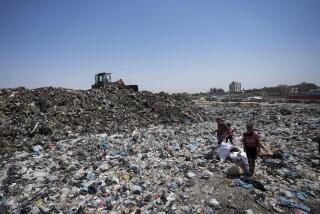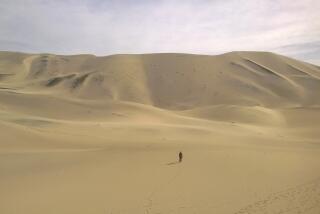Symptom of the Dead Sea’s decline
EIN GEDI, ISRAEL — Eli Raz was peering into a narrow hole in the Dead Sea shore when the earth opened up and swallowed him. Fearing he would never be found alive in the 30 foot-deep pit, he scribbled his will on an old postcard.
After 14 hours, a search party pulled him from the hole unhurt, and five years later the 69-year-old geologist is working to save others from a similar fate, leading an effort to map the sinkholes that are spreading on the banks of the fabled saltwater lake.
These underground craters can open up in an instant, sucking in whatever lies above and leaving the surrounding area looking like an earthquake zone.
The phenomenon, Raz said, stems from a dire water shortage, compounded in recent years by tourism and chemical industries as well as a growing population.
“This is the most remarkable evidence of the brutal interference of humans in the Dead Sea,” he said.
The parched moonscape, famous as the site of biblical Sodom and Gomorra, is the lowest point on Earth and runs more than 60 miles through Israel and the West Bank.
Large sections of the coast are fenced off and with warnings posted in Hebrew and English: “Danger, Open Pits” and “Sinkhole Area Ahead.” But it’s too expensive to inspect every place for danger. Just two months ago an Israeli hiker wandered into an area that had no warning signs and was critically injured when he fell into a sinkhole.
Although such accidents are rare, Raz says there are as many as 3,000 open sinkholes along the coast and probably just as many that haven’t burst open yet. And they’re having a big effect on Israeli development plans.
The collapsing terrain has forced authorities to close a campground, date groves and a small naval base, and to scrap plans for 5,000 new hotel rooms, said Galit Cohen, director of environmental planning at the Ministry of the Environment.
The holes, also found on the Jordanian side of the sea, are the result of the Dead Sea having shrunk by a third since the 1960s, when Israel and Jordan built plants to divert water flowing through its main tributary, the Jordan River.
The holes form when a subterranean salt layer that once bordered the sea is dissolved by underground fresh water that follows the receding Dead Sea water.
The main road along the shore has been torn apart by streams whose energy is increased because they are flowing farther to reach the receding sea, and all construction along the strip between sea and highway is banned, Cohen said.
Israel and Jordan evaporate Dead Sea water to extract its phosphates and have built hotels along the coasts for the thousands of tourists who come in search of the curative powers of Dead Sea mud, or simply for the experience of floating unsinkably in its salt-saturated water.
Only micro-organisms survive in the Dead Sea, but indigenous species of fish, amphibians and snails live in small nearby ponds fed by springs, and these could be wiped out as the Dead Sea gets smaller, Raz said.
Many of the changes are masked at the expensive resorts on the sea’s southern end, which lie on the banks of a large artificial pond built by the mineral industry. But around Ein Gedi, the kibbutz, or communal farm, where Raz lives, the Dead Sea’s shrinkage is evident.
Twenty-five years ago, Ein Gedi built a spa by the sea. Now it’s a one-mile trolley ride from the water.
“Any visitor that’s come back for a second visit in these last 10 years would see a dramatic change,” said Gidon Bromberg, Israel director of Friends of the Earth Middle East, an advocacy group. “The sea has run away from the cliffs and it’s exposed kilometers of mud and sea floor.”
No quick solution is in sight.
The World Bank is studying a proposal to dig a canal from the Red Sea, more than 100 miles south, to replenish the Dead Sea. But with costs estimated at as much as $15 billion, there’s little optimism it will happen.
Without a solution, the sea is expected to lose another third of its area over the next century.
--
Marks writes for the Associated Press.
More to Read
Sign up for Essential California
The most important California stories and recommendations in your inbox every morning.
You may occasionally receive promotional content from the Los Angeles Times.










